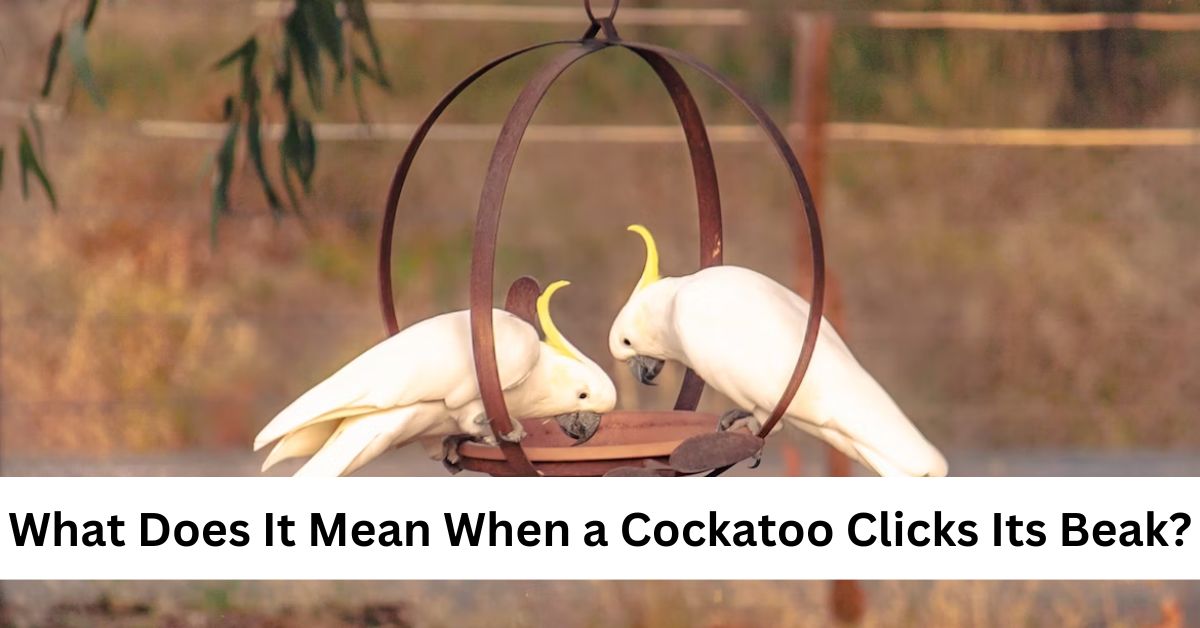Cockatoos are beautiful and intelligent birds known for their unique behaviors, including beak clicking. This article aims to explain the meaning behind Cockatoo beak clicking behavior, its potential reasons, and how it relates to communication.
Understanding Cockatoo Behavior
Before discussing beak clicking, it is essential to understand the nature of Cockatoo behavior. Cockatoos are highly intelligent, social, and emotional birds. They are known for their loud and attention-seeking personalities and their ability to communicate through various methods, including body language, vocalizations, and beak movements.
The beak is a crucial part of a Cockatoo’s life, as it serves many purposes. The beak helps the bird to eat, groom, play, and defend itself. Cockatoos also use their beaks to interact with their surroundings, including objects and other birds.
Meaning of Cockatoo Clicking Beak
Beak clicking is a common behavior observed in Cockatoos. It is a rhythmic movement of the upper and lower beak, resulting in a clicking sound. Different types of beak-clicking behaviors have been identified in Cockatoos, including rapid clicking, slow clicking, and grinding.
The meaning behind beak clicking behavior is not entirely clear, but it is believed to serve various purposes. Some Cockatoo experts suggest that beak clicking is a self-soothing behavior that helps to calm the bird down in stressful situations. Other theories suggest that beak clicking is a sign of contentment, excitement, or affection.
Communication through Beak Clicking
In addition to self-soothing or expressing contentment, Cockatoos also use beak clicking to communicate with other birds and their caregivers. Beak clicking can convey different messages depending on the context, including greetings, warnings, and requests for attention.
Compared to other communication methods, such as vocalizations or body language, beak clicking is less obvious and may be easily missed by those unfamiliar with Cockatoo behavior. However, it is an essential part of the Cockatoo communication system and should not be overlooked.
Signs of Discomfort or Aggression
While beak clicking is generally considered a positive behavior, it can also indicate discomfort or aggression in Cockatoos. Rapid or aggressive beak clicking may be a sign of stress, fear, or discomfort, and caregivers should be aware of these signs Additionally when a Cockatoo feels threatened or provoked, it may resort to aggressive beak clicking as a warning sign.
It is important to pay attention to the context of the beak-clicking behavior and the bird’s overall body language to interpret its message correctly.
Cockatoo caregivers should also be aware of signs of discomfort in their birds, such as fluffed feathers, lack of appetite, or unusual vocalizations. These signs may indicate a health issue or an uncomfortable living environment, and prompt action should be taken to address the problem.
Tips for Cockatoo Caregivers
Cockatoo caregivers should strive to understand and address their bird’s beak clicking behavior. Providing a safe, stimulating, and comfortable living environment for the bird is crucial for its overall well-being. Caregivers should also engage with their Cockatoo through positive reinforcement training, playtime, and interaction to build a strong bond.
In addition, caregivers should provide adequate nutrition, regular vet check-ups, and appropriate mental and physical stimulation to promote a healthy and happy Cockatoo. Understanding the bird’s body language, vocalizations, and beak movements can also help caregivers to communicate effectively with their Cockatoo and provide the best possible care.
Conclusion
In conclusion, beak clicking is a common behavior observed in Cockatoos that serves various purposes, including communication, self-soothing, and expression of emotions. Caregivers should strive to understand their Cockatoo’s beak clicking behavior and interpret its message correctly, as it can indicate both positive and negative emotions. By providing a positive living environment, building a strong bond, and addressing any potential problems promptly, caregivers can ensure the well-being of their beloved Cockatoos.
FAQs
- Is beak clicking behavior the same in all Cockatoos?
- No, different types of beak clicking behaviors have been identified in Cockatoos, and the meaning behind the behavior may vary depending on the context.
- Can beak clicking indicate a health issue in Cockatoos?
- Yes, rapid or aggressive beak clicking may indicate discomfort or stress, and caregivers should pay attention to other signs of discomfort in their birds.
- Can beak clicking be a sign of affection in Cockatoos?
- Yes, some experts suggest that slow and gentle beak clicking may indicate contentment and affection in Cockatoos.
- How can caregivers address aggressive beak clicking behavior in their Cockatoos?
- Caregivers should identify the source of stress or discomfort and address it promptly. Positive reinforcement training and providing a comfortable living environment may also help to reduce aggressive beak clicking behavior.
- Can Cockatoos communicate effectively through beak clicking alone?
- No, while beak clicking is an essential part of Cockatoo communication, it should be considered along with other communication methods, such as vocalizations and body language, to understand the bird’s message correctly.

